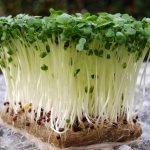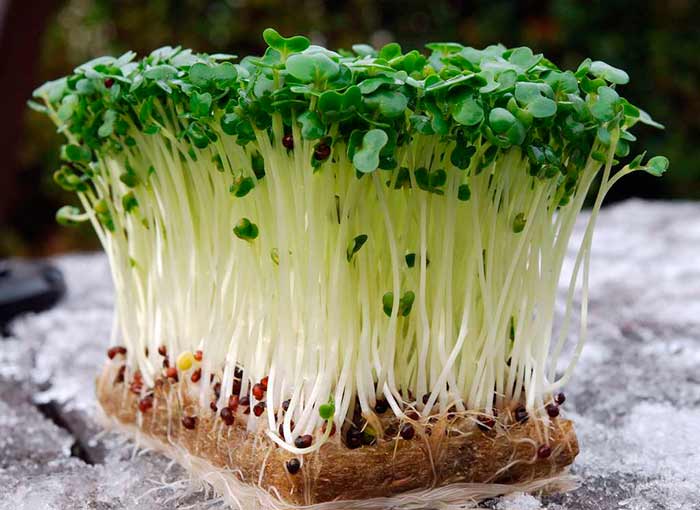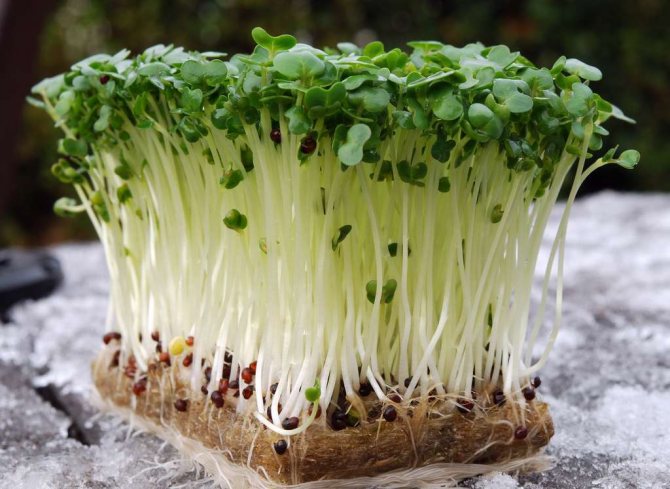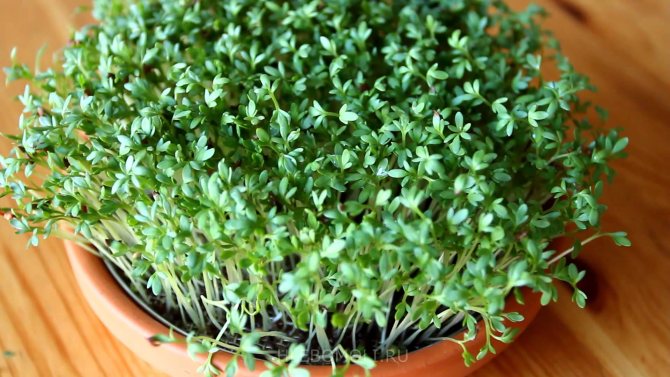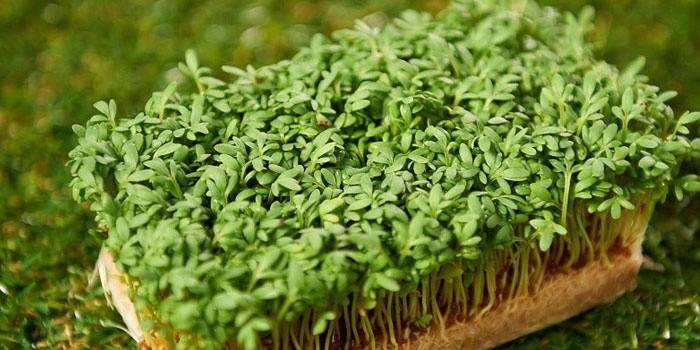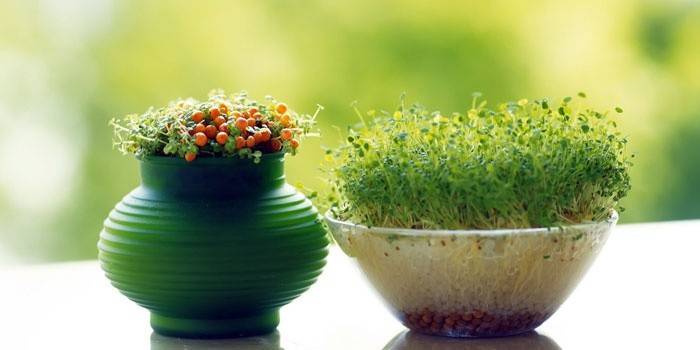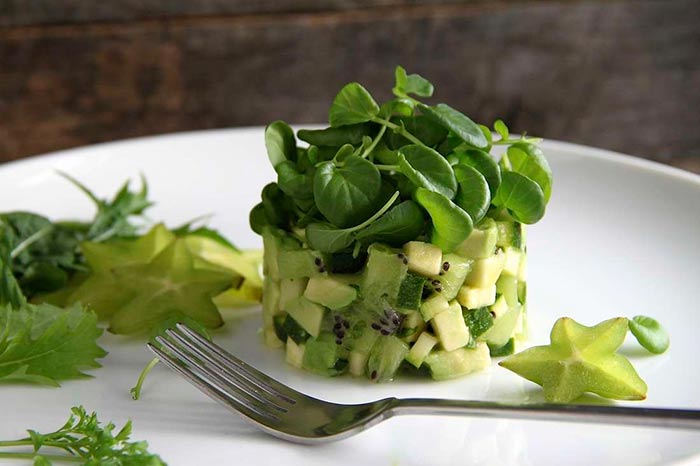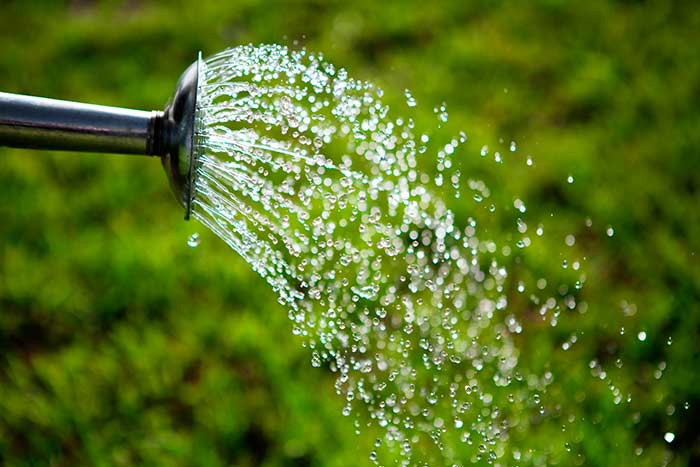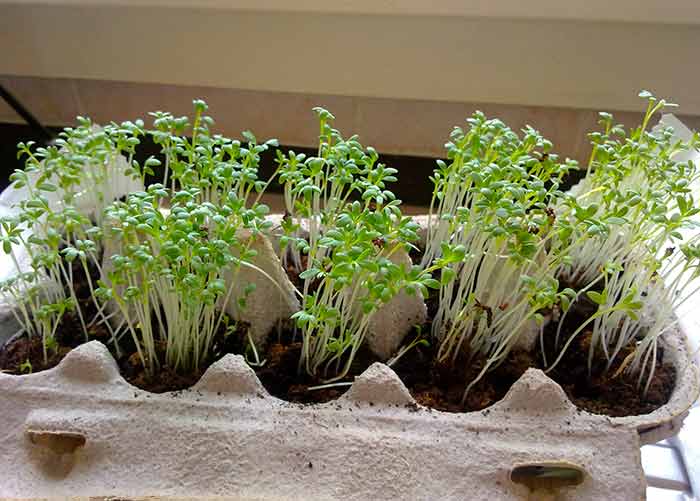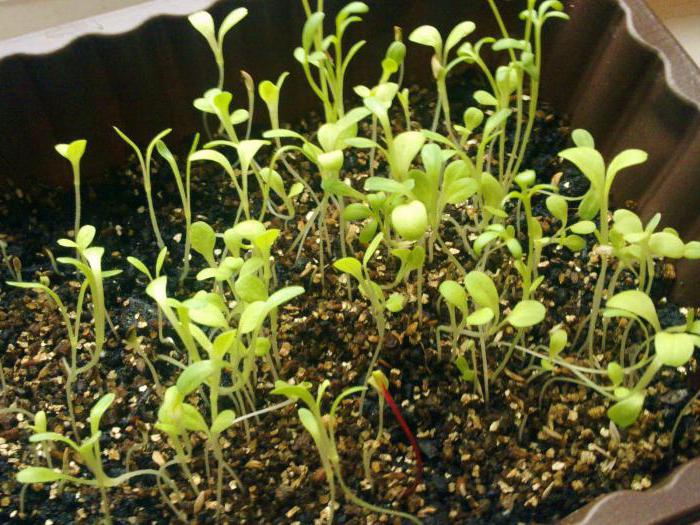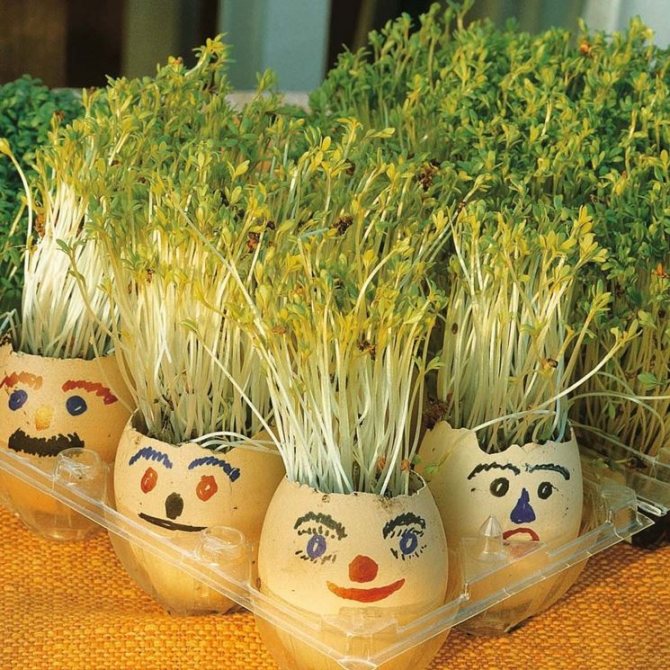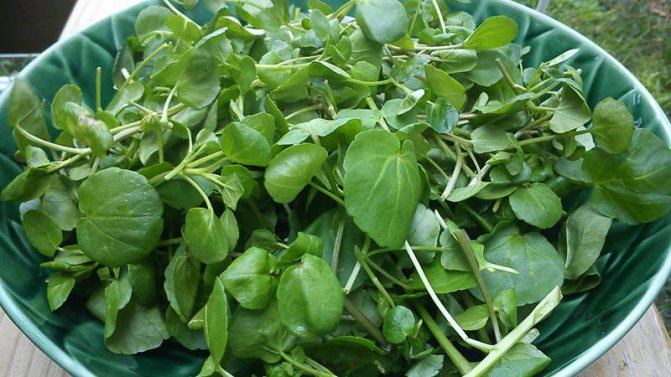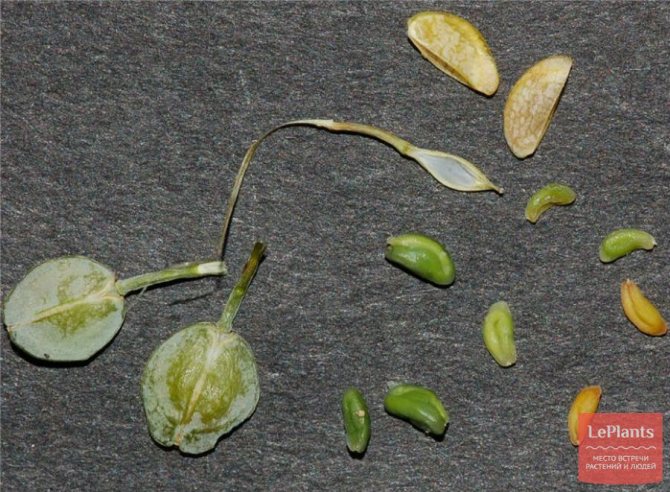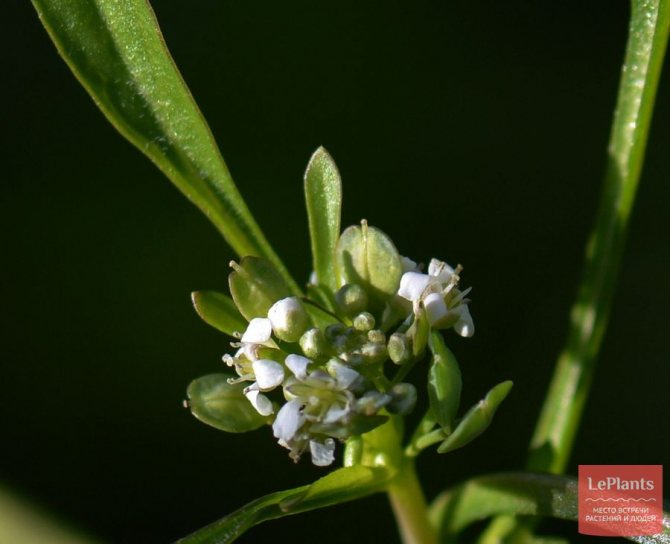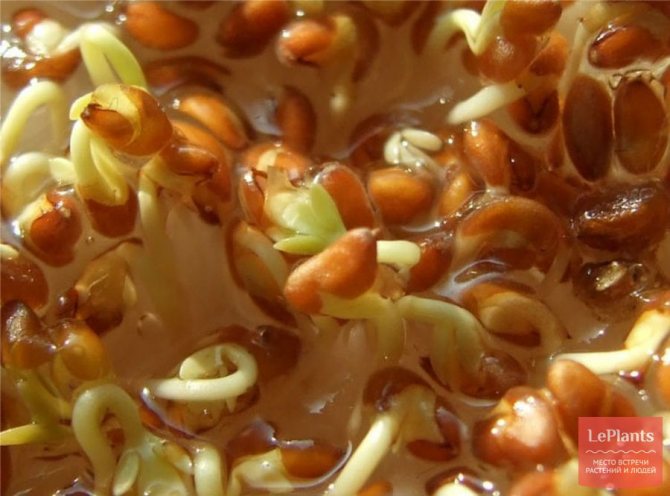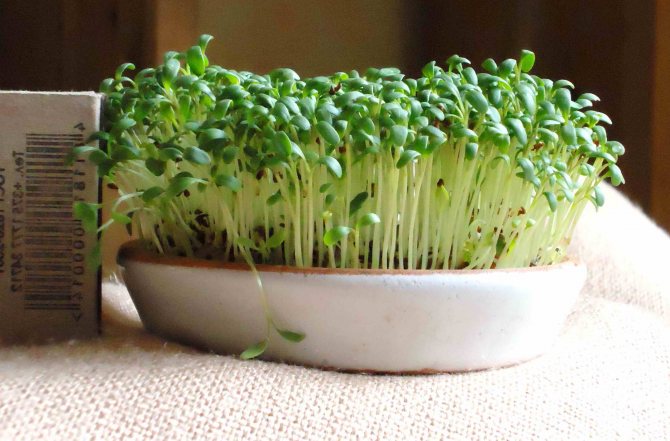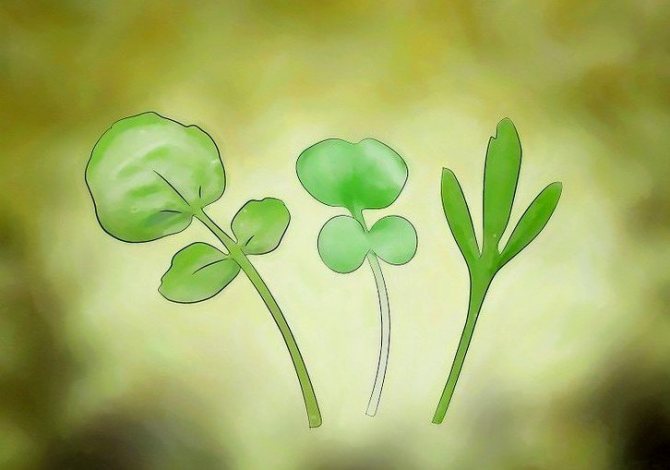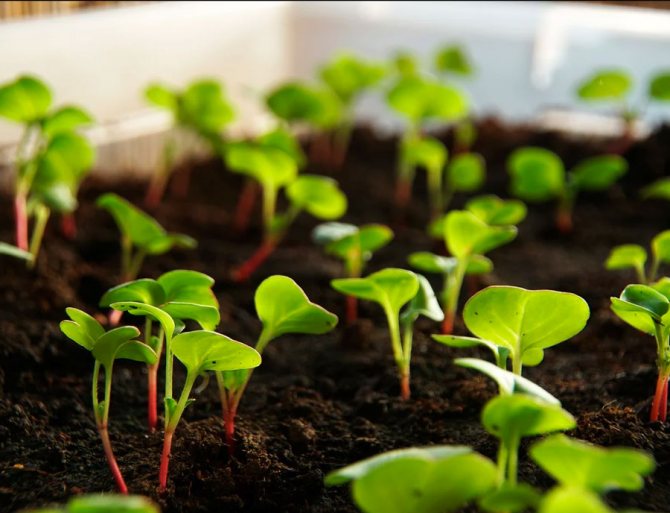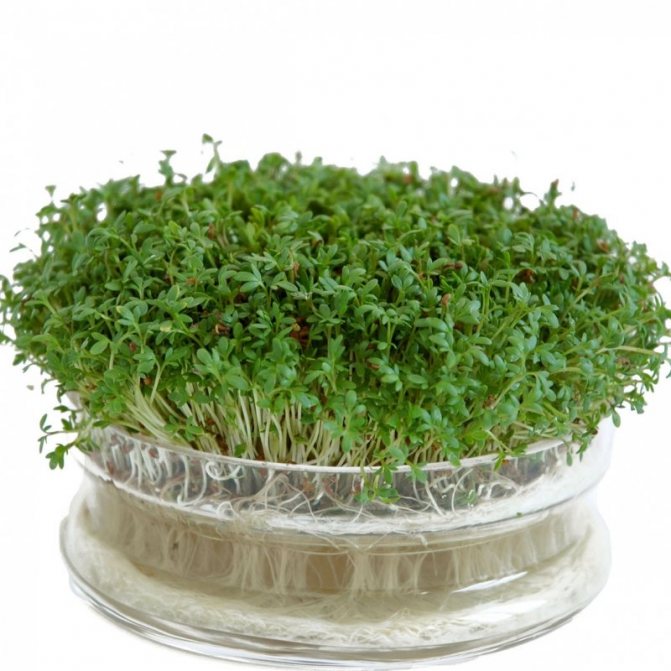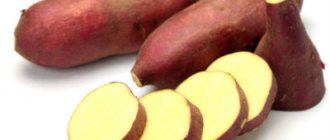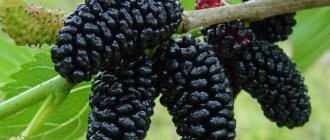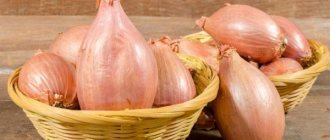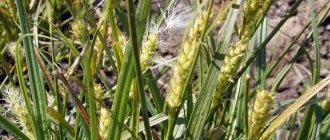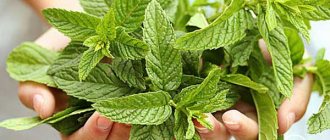Watercress is an increasingly popular vegetable with a tangy flavor. It owes this to mustard oil, which is part of its chemical composition. Often, those who first try its greens say that it resembles mustard or horseradish. Nevertheless, its valuable and useful properties have been known since ancient times.
The ancient Greek philosopher and healer Hippocrates used salad-cress as a regenerating agent, purified the blood with it and charged the body with vital energy. The ancient Egyptians used it as a medicine for potency and libido. In the Middle Ages, the plant reached Europe, where it was in greatest demand among the inhabitants of Germany.
Its spicy taste is gaining more and more the hearts of consumers. This plant is also in demand because it is very easy to grow it, not only in garden beds, but also at home on the windowsill. In addition, it appears much earlier than other green vegetables, easily tolerates frost and grows quickly.
Composition and useful properties of watercress
The plant is characterized by an abundance of varieties, but they are distinguished by the methods of cultivation, early maturity and shades of taste, but the chemical composition and useful properties of watercress have few differences.
The main advantage of the culture is a significant content of vitamins of groups A, B, C, K, PP, E, mineral components (potassium, copper, iron, phosphorus, etc.). This composition determines the health benefits and harms of watercress.
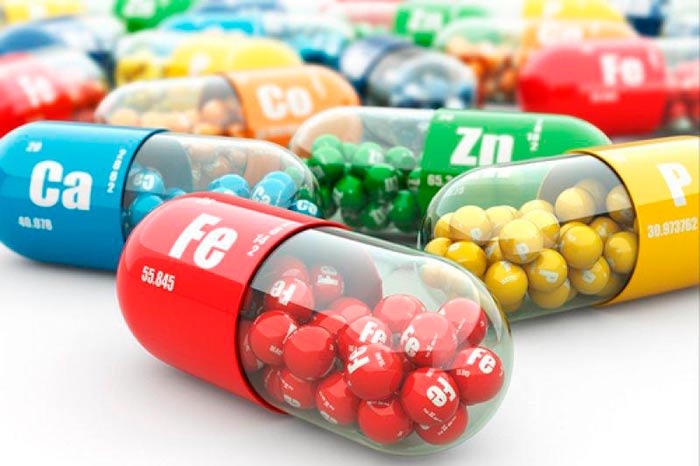
Watercress Salad Care
Timely watering is the most necessary condition for full, proper care of the plant. Other factors aside, it is important to remember that water is the watercress medium. Lack of moisture instantly affects the taste of the green leaf. It goes into the arrow and becomes bitter, almost unusable.
On hot days, watering is carried out up to twice a day. If the weather is rainy, one watering every three days is enough.
If, for some reason, when preparing the site for planting, the soil was not fertilized, you should pay attention to top dressing. It should be liquid, balanced, low concentration. It is worth adding in the minimum amount, extremely carefully. Taking into account the rapid maturation and achievement of nutritional value, the greens may not have time to process the nitrates added to the soil.
The remaining procedures are reduced to infrequent loosening and removal of weeds. Loosening will help to provide an additional flow of air and nutrients to the plant roots.
Chemical composition
Watercress is rich in vitamin and mineral composition... The following elements predominate in the plant:
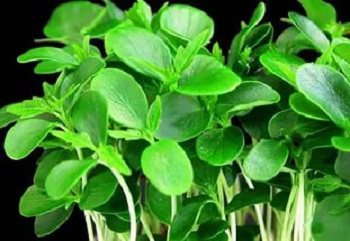

- vitamin A - improves vision, is necessary for healthy hair, skin, nails;
- B vitamins - participate in almost all processes of the body, are necessary for the normal life of a person;
- vitamin C - ascorbic acid strengthens the immune system;
- vitamin K - improves blood formation. Lack of this vitamin leads to fatigue, bleeding gums, increased hemorrhage;
- vitamin PP - participates in redox reactions;
- vitamin E - is necessary for the normal functioning of the reproductive systems in women and men;
- mineral elements - copper, iron, potassium, calcium, magnesium, phosphorus.
The nuances of plant care
Another advantage of the plant is its simplicity. Therefore, caring for a culture is a simple and not time-consuming exercise. It is worth adhering to the following rules in order to grow a delicious seasoning on the windowsill in winter:
- water regularly with clean warm water, do not allow the soil to dry out;
- it is necessary to monitor how the watercress grows: if it starts to darken, rot or becomes stained - it is worth reducing the intensity of watering, if it coarsens, becomes thinner or becomes sluggish - moisturize the kidney more often;
- spraying from a spray bottle will make the culture juicy and healthy;
- top dressing is optional, you can add potash fertilizers or urea solution before sowing.


Another question is how to cut the watercress. Firstly, it is worth remembering how long the plant needs to ripen - 1-2 weeks. It is during this period that the harvest should be harvested, otherwise the seasoning will be bitter and tough. Secondly, the most suitable tool is sharp scissors. You need to cut the plant carefully so as not to damage the stems - they contain many useful substances.
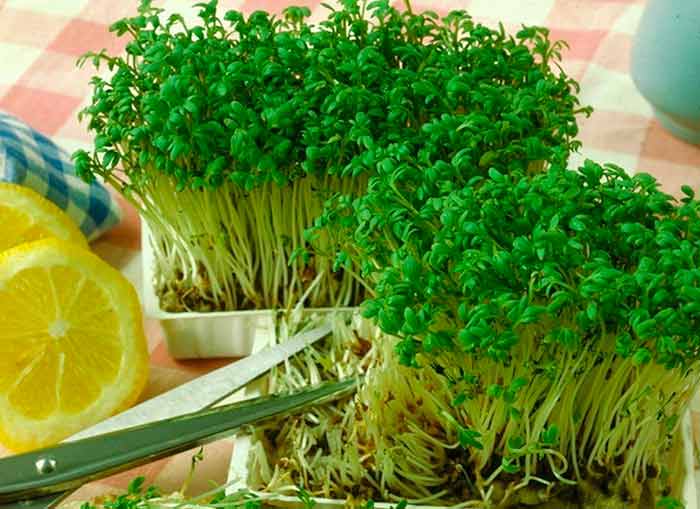

Growing a delicious watercress at home is a quick way to get your fill of vitamins and minerals during the colder months. You just need to follow a simple technique on how to grow watercress on a windowsill and do not forget about regular maintenance.
Did you like the article? Like it ♥, subscribe to our channel and you will be one of the first to know about new publications!
And if you have something to share - leave your comments! Your feedback is very important to us!
Application in cooking and cosmetology
Watercress has long been used for food, this is due not only to its medicinal effect, but also to its unique culinary qualities. The plant tastes spicy, similar to mustard or horseradish, but the shade is fresher and lighter. Due to its ability to spice up dishes, watercress is used in cooking to prepare salads, first courses, and snacks.
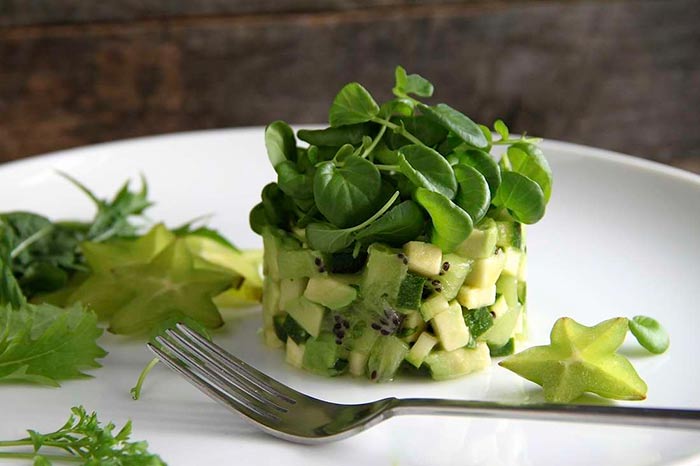

To get a closer look at the culinary purpose of the plant, below are popular recipes for dishes with this ingredient.
| Name | List of products | How to cook |
| Vitamin salad with watercress | Carrots - 100 g; Watercress - 200 g; Honey - 1 tbsp. l .; Olive oil - 2 tbsp l .; Lemon juice - 1 tbsp l. | 1. Grate carrots, add salad. 2. Season vegetables with a mixture of lemon juice, honey and oil. If desired, add your favorite spices, sprinkle with sesame or pumpkin seeds |
| Watercress and shrimp puree soup | Shrimp - 0.5 kg; Garlic - 2 cloves; · Watercress - to taste; Butter - 25 g; Shallots - 3 pcs .; Almond petals - to taste; Cream (15%) - 50 ml; Broccoli - 300 g. | 1. Fry finely chopped onion in butter. 2. Send broccoli sprigs to the vegetable, add water (so that it completely covers the product), simmer until tender. 3. Using a blender, turn the broccoli into gruel, pour in the cream. 4. Fry garlic and shrimps (peeled beforehand) in vegetable oil. 5. Serve broccoli puree with shrimp and garnish with watercress and almond petals. |
Watercress and arugula, being close relatives, go well in dishes. Such products include "green" spices: mint, parsley, marjoram, hops-suneli. Microgreens are revealed in vegetable dishes, as an addition to meat or fish (fresh).
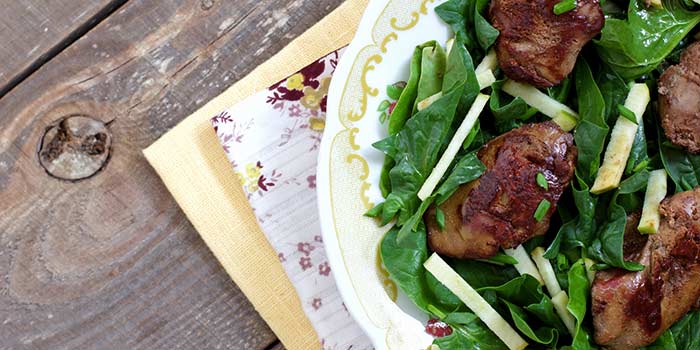

Culture is irreplaceable in cosmetology. The powerful cleansing and regenerating effect makes herbal products beneficial for women of all ages. Examples of masks are described in the following table.
| Name | Appointment | The constituents |
| Mask for oily skin | Mattifies, normalizes sebum production, tightens pores | Greens (grated) - 2 tbsp. l .; Honey - 1 tsp; Protein - 1 pc. |
| Purifying mask | Cleans, rejuvenates, soothes | Olive oil (cosmetic) - 1 tsp; Lemon juice - 5-10 drops; Greens - 8-10 leaves |


Method of applying masks: mix the ingredients, apply on the face, wash after 10-15 minutes.
Growing watercress on a windowsill
It is necessary to take a container and lay a drainage layer (broken brick, expanded clay) 1 cm thick in it, making sure in advance that the container has drainage holes. Further - the substrate with a layer of 2-3 cm, which must be very well moistened with water at room temperature, then add the substrate to a height of 8-9 cm and moisten again. After 10-15 minutes after moistening the substrate, it is necessary to make rows in it 0.5 cm deep with a distance between them 12-16 cm, depending on the type of watercress - the higher it is, the more distance you need to do.
Next, we sow seeds into the grooves, pre-soaked in water for a quarter of an hour, and sprinkle them with a centimeter layer of soil.
After that, cover the container with the sown seeds with cling film or glass and make sure that the soil does not dry out, periodically moistening it from a spray bottle.
At the same time, the temperature in the room needs to be maintained at a comfortable level and you and I will have + 21 ... + 22 ° C and try to keep the temperature not lower than + 18 ° C, otherwise the seedlings will not appear soon, and will not rise above + 25 ° C - then even young plants will be very bitter ...
Usually, seedlings appear within a week and, as soon as they appear, the film must be removed from the container and try to lower the temperature in the room to + 16 ° C. At this temperature, the root system of the watercress develops more actively and in the future it will develop better.
Further care for watercress is completely uncomplicated and consists in periodic watering with water at room temperature from a spray bottle as the soil dries up, as well as in humidifying the air near the watercress in the same way. A week after the emergence of seedlings, the temperature should be brought to normal, equal to + 21 ... 22 ° C.
Top dressing. 8 days after sprouting, watercress can be fed with nitroammophos by dissolving a standard teaspoon of fertilizer in a bucket of water and adding 1 liter of the resulting solution per square meter of dishes. If the salad grows well, then it makes no sense to additionally fertilize the soil - act as appropriate and remember that excess nutrition can turn into harmful substances that accumulate in the leaves, so you cannot exceed the indicated dosage.
Watering. It is extremely important to prevent even a short-term drying out of the soil in the container where the plants grow - if moisture is in short supply, the plants may die.
Lighting enough from the window, for which the salad must be placed on the southern windowsill and once a day turned over to the other side to the light so that the plants develop normally.
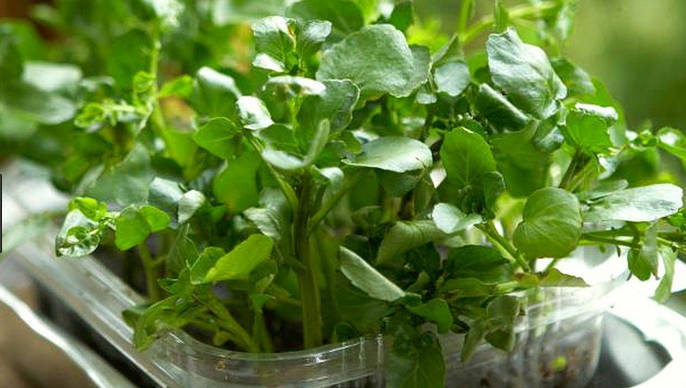

Watercress
Description of the plant, cultivation and care
Watercress comes in many different names and varieties. In Afghanistan it is called tertizak, in Georgia it is called tsitsmati. For Armenians, it is known as kotem, and in Ukraine - watercress or watercress. You can often hear other names as well: horseradish, garden cress or peppercorn.
There are several varieties of plants: curly, whole-leaved and sowing. Each species has its own characteristic differences and varieties.
For example, curly watercress has a small semi-raised rosette and intricately cut leaves. The rosette reaches seventeen centimeters in diameter. A typical representative of this group of salads is the "openwork" variety. It also includes early maturing and mid-maturing plant varieties.
The whole-leaved variety of lettuce is characterized by a fairly large horizontal rosette, up to twenty-one centimeters in diameter. This type usually grows up to five to six centimeters in height. This group includes late-ripening varieties, the most striking of which is "ducat".
The seed watercress is a cross between the two previous varieties. Its rosette, large and semi-raised, has weakly dissected large-sized leaves. This group includes the most early ripening varieties: "Kurled", "Zabava", "Danish".
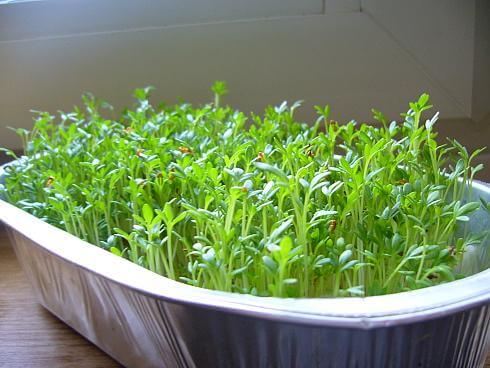

Other plant varieties include broadleaf and narrow-leaved watercress, news, curly-leaved, common watercress, local, spring and others.
Watercress is a species of the extensive cruciferous family of the genus Bugwort. The leaves of this vegetable crop are green, slightly bluish in color. Blooms in June with white or pink flowers. Fruits - pods ripen closer to mid-autumn.
Watercress is a picky and unpretentious plant. With proper care, the fresh greens of the plant will delight you all year round.
The cultivation of such a vegetable crop does not require significant labor costs. It can even grow on sand. But if you decide to grow it in the garden, it is advisable to prepare the soil for this in the fall. To do this, you need to remove all the weeds, dig up and add humus. In the spring, the soil must be fluffed and fertilized with compost or mineral complexes.
The seeds of the plant are sown in early spring, and after just a month and a half of intensive growth they become edible. It can be planted for the winter, it can withstand frost and cold-resistant.
As a rule, you need to sow it in rows, but it grows well in continuous beds. The watercress seeds are quite large and can be easily spread evenly in the row, deepening by about one centimeter. The distance between the seedlings should be about five centimeters so that the rosette of the plant turns out to be large. The first shoots appear within three days after sowing.
However, the landing is not everything. In order for the plant to grow quickly and well, it must be watered in a timely manner. If this is not done, then the bug will throw out the arrow, and its leaves will become rough and tough.
How to properly water the plant:
- In the heat of summer, be sure to water the watercress every day.
- In cloudy weather, one watering is enough for three to four days.
- Waterlogging, as well as a lack of moisture, negatively affects the plant, therefore it is important to observe the optimal watering regime, and then the grass will be less susceptible to various diseases and pests.
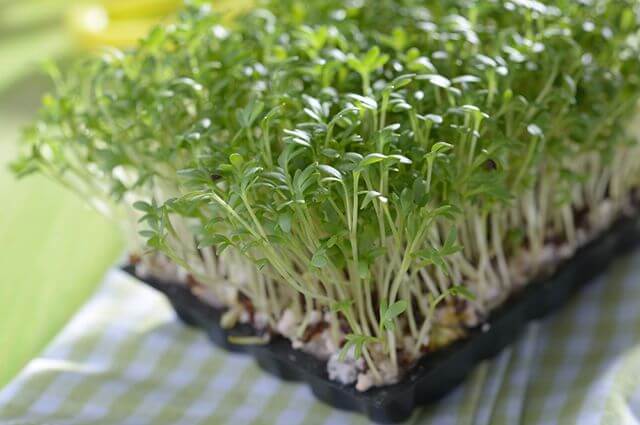

You should also not forget about loosening the soil and getting rid of weeds.
The plant propagates with the help of seeds, and in order to use lettuce greens for quite a long time, they can be sown several times a year.
Varieties
There are three types of watercress:
- Curly. Looks “curly” due to heavily cut leaves. The most common. Popular varieties of this type: mid-early "Azhur" (ripens in 20 - 25 days), mid-season "Curly" (32 - 40 days).
- The whole-leafed form has leaves with whole (not cut) edges. Bushes are more voluminous and squat than curly ones. The most popular variety is the ultra-early ripening “Ducat” (can be consumed after two weeks).
- Sowing watercress. In appearance, it is a cross between the other two species: the leaves are dissected, but not much. Early ripening. Popular varieties: "Dansky" (up to 14 days); "Kurled" (15 - 17 days); "Narrow-leaved" (15 - 20 days); "Fun" (25 - 30 days).
Infusion of watercress leaves
In folk medicine, the most famous remedy is an infusion of microgreen leaves. The cooking method is as follows:
- Mix dry lettuce (2 tablespoons) and fresh plant (3 tablespoons).
- Pour boiling water over the mixture (1 tbsp.).
- Let it brew in a thermos or a closed cup for 2-3 hours.
To cleanse the body, restore the cardiovascular system, with coughs and nervous disorders, it is recommended to take 1/3 cup before meals.


What does watercress look like?
The annual vegetable plant is popular with culinary specialists. When figuring out how homemade watercress grows, it's worth noting that it has a thin stem with lots of leaves and a simple root. As long as the stem is white, the plant is considered young and can be eaten. Flowering is observed in June or July, so during this period white or pink flowers appear, after which a pod fruit is formed. Watercress, whose species differ in appearance, is undemanding, so there should be no problems with cultivation.
- Whole-leaved. The plant can be early or late maturing. Its rosette is large, and the leaves are narrow and little cut.
- Curly. The rosette is small and is 17 cm. The leaves of the grown watercress on the windowsill will be heavily cut and raised. There are early and mid-season varieties.
- Sowing. In this species, the rosette is large and is 19-21 cm. The leaves grow horizontally and have a wide, solid shape.
A few words about how to properly eat the grown watercress on the windowsill. It is best to include it fresh in recipes, so it retains the maximum benefits. It is worth noting that the taste of greens is similar to a pungent mixture of horseradish, radish and garlic. It is best to combine watercress with olive oil. The young plant perfectly emphasizes the taste of cheese, cottage cheese, cold soups and sauces. It goes well with legumes, pears, apples, eggplants and other vegetables. It is better to tear the salad with your hands, not cut it.
Influence on the body
Watercress - healthy and tasty greens... This is a dietary product, it is recommended to use it for people who are losing weight. The plant is a strong allergen, so it is not recommended to include it in the diet of allergy sufferers.
In the absence of contraindications, watercress can be entered into the menu, regardless of age... The rich vitamin composition will strengthen the immune system, support the body of any person.
For adult men and women
The plant is especially useful for the male population, because it enhances sexual activity. For this, unripe seeds are used. Alcohol tincture is effective in treating prostatitis.
For women, watercress is beneficial in that it has a rejuvenating effect... Smoothes fine expression lines, refreshes the skin. Regular use of masks can help treat skin conditions.
What is useful during pregnancy and lactation
Greens prevent constipation, improve bowel function, gently affects its peristalsis. Due to these properties, watercress is recommended to be included in the diet of pregnant women if they are not allergic to the plant.
Watercress is a strong allergen. It can be used by a nursing mother if the baby has no reaction to the product. Before introducing greens into the diet, you should consult your pediatrician.
For kids
Watercress should be added to the children's menu no earlier than three years... At an earlier age, the plant can negatively affect the gastric mucosa. After the first use, make sure that the baby does not have allergies.
Greens will strengthen the immunity of children, regular use during the season of mass epidemics will protect against disease. It also improves mood.
For seniors
If there are no contraindications, watercress can be consumed by people of the elderly age group. Leaves of grass improve well-being, help to gently establish the work of the digestive system.
The plant can be included in the menu as a prophylactic agent against diseases of the cardiovascular system. By lowering cholesterol, greens prevent heart attacks, ischemic disease and strokes.
The benefits of watercress
- Its fresh leaves rich in mineral salts
potassium, calcium, phosphorus, iodine, iron, magnesium, sulfur, copper, etc. - Contain ascorbic acid, B vitamins, carotene, thiamine, rutin, riboflavin, mustard essential oil
, including the glycoside propsolin and giving it a specific smell and taste. - The roots and aerial parts of the plant contain a bitter substance lepidine
, seeds - up to 50-60% of semi-drying fatty oil. - Watercress improves digestion, sleep, stimulates appetite, has antimicrobial and diuretic effect, lowers blood pressure, it is indispensable for respiratory diseases. It is good to gargle with juice squeezed from the grass, drink it when coughing.
- Due to the content of ascorbic acid, it has an anti-scurvy effect.
- The aerial part and roots, containing the bitter substance lepidine, were used for fevers; juice from the leaves was used for anemia, powder from crushed seeds - instead of mustard plasters.
,
There are a great many types of salads, but many varieties are especially revered in the cuisines of the world. Watercress is one of the most popular because it combines many positive properties, ranging from a unique taste and aroma to the simplicity of agricultural technology.
Moreover, it should be noted that watercress, which is often grown in the open field, grows well at home, even on the windowsill of an ordinary city apartment.
The plant is considered one of the most unpretentious, and to such an extent that to grow it at home, you will not have to cook any specific soil or look for any specific varieties. Moreover, it is best to experiment with several varieties and settle on a more suitable one. With the soil, everything is much simpler, and so much so that some experienced gardeners plant lettuce seeds to other crops, for example, growing, or to moisture-loving home flowers.
To prepare for planting, you need to decide exactly how the salad will grow, since there are several landing options:
- in the soil mixture;
- into a cotton-gauze base;
- into a combined base.
Video about growing watercress
In the first case, for growing lettuce at home, you can take any soil that is fertile or what you can get. But keep in mind that the most suitable will be a specialized soil mixture from the store, least the earth that you dug next to the road or on the playground. In principle, you can compromise and take the soil from your garden plot, having previously removed all the weeds from it.
In the second case, cotton wool wrapped in gauze is used as the base. Naturally, both cotton wool and gauze must be from a pharmacy, and the density of the latter must be sufficient for long-term use.
The third case implies a kind of "layer cake", which includes (from the bottom up) drainage in the form of a sand-gravel mixture, a cotton-gauze layer, a fertile soil mixture. Drainage is necessary to remove excess water, the cotton-gauze layer will retain the required amount of moisture, and the soil will provide the plant with microelements. It is the combined method that is suitable for those who have no experience at all in growing plants either on the windowsill or in the garden, since it practically will not give a chance to ruin the greens.
You can grow greens at home in any container up to 50 mm high
You can grow greens at home in any container up to 50 mm high, since the base layer does not exceed 30-40 mm. However, it is worth remembering that for a combined base, a height of 40 mm is required, and for a cotton-gauze base, 30 mm will be enough. This is due to the fact that the plant itself is small, and its root system is quite compact.
Planting watercress seeds at home is done by seeds directly into the base, without any preliminary treatment.However, the landing technique varies somewhat depending on the top filling. For a combination or soil base, simply scatter the seeds and lightly dust them with soil. But if the base is cotton-gauze, then the seeds are scattered only over the cotton, and only then they are covered with gauze on top. It is believed that even in this case, it is necessary to cover the seeds with nutritious soil, but this will not bring practical benefits.
Just before planting, the base is watered abundantly. Immediately after disembarkation, it is sprayed from a spray bottle. Under no circumstances should it be watered with a stream, as the stream of water will be able to wash out the newly planted seeds. It is also important to keep in mind that there is no need to make the seeds float. The substrate must be damp, but not over-spilled.
It is also important to keep in mind that you do not need to make the seeds "float"
After planting has been carried out, the container with watercress is removed to a shaded cool (6-8 degrees Celsius) place, as this, on the one hand, will prevent excessive evaporation of moisture and, on the other hand, will not cause rotting of seeds or the appearance of fungal infections. , mold.
It is especially important to observe the temperature regime at home if the soil was taken from a personal plot, or the planting is done in a cotton-gauze base.
The temperature rises to room temperature only when the first leaves appear. However, you should not put a container on the battery either, it is best to maintain the mode within + 15 ... + 18 g. Celsius.
To grow delicious greens, having created, you need to take care of it, which boils down to a few simple rules.
- Watering
Watering should be regular and abundant, since the plant is moisture-loving and does not tolerate the lack of water. Perhaps a failure in watering is a little that can instantly destroy a culture. It is best to water from a spray bottle, washing the foliage - then the greens will be especially delicate and fragrant. Constant humidity in the room will also be important, because when it fluctuates, the foliage can begin to taste bitter, or even inflorescences will form altogether.
Watering should be regular and abundant.
- Light mode
Watercress loves shaded areas, but that doesn't mean it doesn't need light. It is best to grow it on a windowsill or in a loggia on the north side, hiding the plant from direct sunlight, which is detrimental to foliage. In winter or during the polar night, you can replace natural lighting with any artificial one, and even LED strips with a warm glow temperature are suitable. It is also important to remember that the source of additional illumination should be moved away from the plant by 300-400 mm to prevent heat damage to the leaves. In no case should halogen lamps be used, as they can burn the plant. The container should be constantly tucked up so that growth goes not in stretching the stems, but in straightening the foliage.
- Temperature
Watercress does not tolerate heat very well. Therefore, in summer, it is allowed to grow on windowsills facing the north side, and in winter - away from heating devices and batteries. The minimum suitable temperature will be +15 degrees Celsius, the maximum is +20 degrees Celsius, and the optimal one is +18.
Harvested immediately before use, in small portions, since the watercress is practically not stored - it quickly withers, loses its taste. It is necessary to cut it off with ordinary scissors, and no later than a week after the appearance of foliage. This is due to the fact that the greens begin to quickly lose their taste, become rough and can even give a bitterness. When harvesting, only the leaves with the minimum length of the stalk can be cut, since the latter has practically no taste or aroma.
Video on how to grow watercress
In order for the crop to be regularly available, you can choose a salad by variety, or sow it once a week. If you choose planting by varieties, then you can choose the following combination:
- grade Flagman. Reaches maturity in 12-17 days from the moment of germination;
- grade Pikant. Reaches economic validity in 15-20 days from germination;
- grade Zabava. Technically ripe 20-30 days after germination;
- grade Accord. Ready for use in 25-35 days from the moment of germination;
- grade Dukat. It grows in 18 days from the moment of germination.
Harvested just before consumption
For constant overseeding, especially in winter, the Temp variety will be ideal, which reaches technical maturity in 18-23 days.
Watercress (or klopovnik sowing) was brought to European territory from Egypt and the countries of the Middle East. Today, there are over 200 species of this herbaceous annual growing around the world with a refreshing taste.
Early spring, when hot days have not yet come into their own, is considered the ideal time to plant watercress. It is growing from seeds in the open field that will be the key to obtaining a tasty and mineral-rich green leafy vegetable.
Contraindications
Much is known about the benefits of a plant, but there are also cases when a culture can negatively affect the body. You should not use watercress greens for such violations:
- tendency to allergies;
- hypotension (low blood pressure);
- gastrointestinal tract lesions - enterocolitis and colitis, gastritis, stomach or intestinal ulcer.


Pregnant women are allowed to use the product, but after consulting a doctor. The plant is able to relieve constipation, puffiness, but it is a strong allergen, so a negative reaction of the baby is possible.
Success secrets
When growing watercress, you can sow a new batch of seeds every seven to ten days. Thus, fresh herbs will be in the garden for a long time. However, with the arrival of the heat, you should take a break until the end of August. At high air temperatures, the plant wilts.
Watercress thrives better in partial shade than in well-lit areas. With an excess of light, the plant shoots, not having time to grow foliage. It is permissible to grow it as a compacting crop with cucumbers or tomatoes.
Greens need regular watering. In drought, it weakens, the leaves become tough and tasteless. It is very important not to overdo it, because the watercress instantly rots in the flooded soil.
How to choose a good product, photo
The plant is sold in the market or in the vegetable section of supermarkets.
Choosing a quality product consists of several parts:
- inspect the plant visually: leaves must be free of visible damage (tears or holes);
- the color of a good product is bright, uniform, with the exception of the yellow-green and green-bluish varieties;
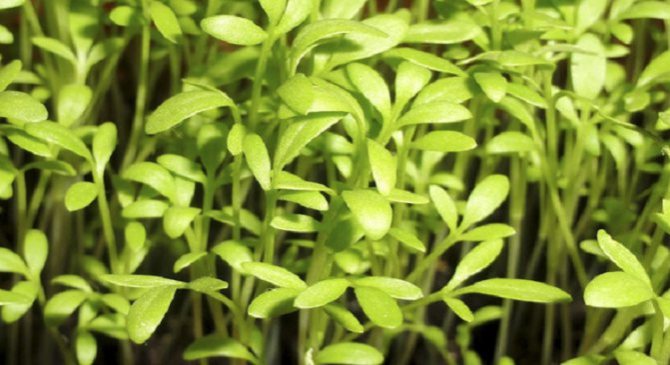

- try the leaves by touch - fresh watercress will have firm and juicy leaves. Don't buy a plant with wet, sticky, or dirty leaves;
- watercress can be sold in pots (with root system and in the ground) is the best thing that can be bought if there is a choice of product options.
Store the plant in the refrigerator in a plastic container. Cut watercress retains its properties for two days.
... and in the soil
You need to pour fertile soil into the container (about 7 cm). After that, make even grooves (depth 0.5 cm). The distance between the grooves should be 10-15 cm. The seeds are covered with a thin layer of soil (about 1 cm).
Seeds can be sown in a chaotic manner - just pour them out of a glass after soaking, level and cover with earth.
After that, the container must be covered with foil. If the room is warm enough (20-23 degrees), then you can leave the container without a film.


With this method, the seeds will germinate a little longer (about 2 days), as they germinate through the soil. When the sprouts appear, the temperature should be reduced to 10-15 degrees. This will help the plant develop a strong root system and prevent them from pulling out.
After seed germination, you need to care for the plants in the same way as described in the first method.
Healthy recipes
Here are some popular and uncomplicated, but useful recipes for those wishing to try the healing properties of watercress:
- Protomit about a hundred grams of fresh raw materials over low heat for no more than 7 minutes after boiling in 300 g of water. Take 60-70 g half an hour before meals, the last intake - an hour before bedtime, in order to normalize night rest, calm down, and stop anxiety.
- You can avoid the negative effects of chemotherapy by preparing a mixture in a 1: 1: 2 ratio, from freshly prepared juices of beets, carrots and our vegetable, and drinking 2 tablespoons half an hour before each meal.
- If, with persistent hypertension, about one hundred grams of fresh leaves of this wonderful remedy are included in the daily diet, the tonometer readings when measuring pressure will soon show the cherished normal numbers.
- When treating sexual dysfunction in men, it is recommended to finely chop 50 g of fresh herbs of the miracle salad and parsley, add the same amount by weight of chopped cashews and 1 tbsp. a spoonful of lemon juice, take a freshly prepared composition for about two weeks at night.
- If you freeze the watercress juice and then rub your face with ice in the morning, your skin will soon take on a fresh and healthy look.
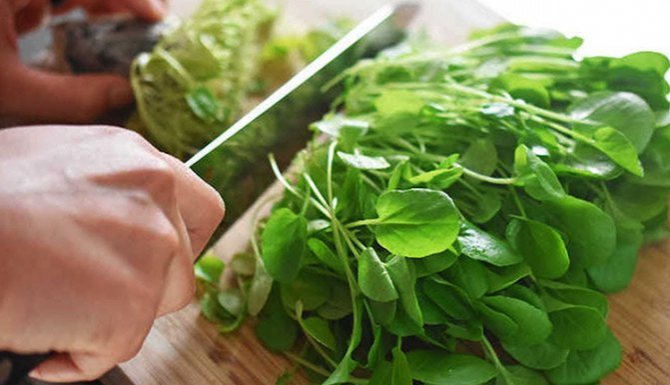

Breeding watercress without using soil
How to grow a salad without soil? The soilless method is simple in that any substrate is used for planting seeds - a sponge, cotton wool, and even a paper towel. The capacity for the culture is different: a bowl, a plate, a plastic container.
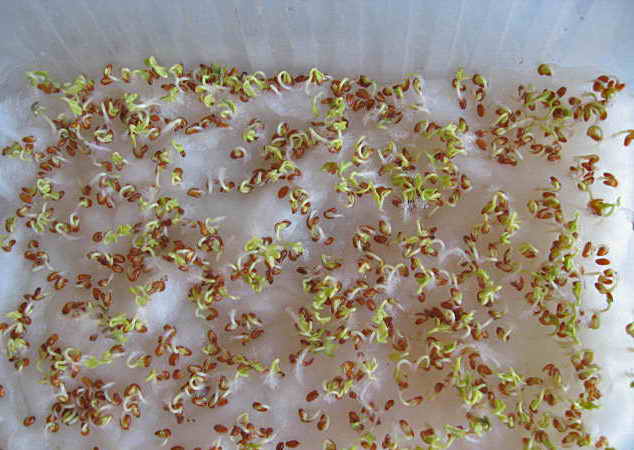

Spring is considered the best time to plant cress seeds. Disembarkation is carried out as follows:
- suitable dishes are selected;
- on the bottom of the container, the substrate is laid out with a layer of at least 2 cm and moistened with water;
- lettuce seeds are soaked in a little water and then sprinkled evenly on the prepared base for sowing. We sow grains in a thin layer;
- the top of the container is covered with foil to create a greenhouse effect, and placed in a cool, dark place.
Within a day, germination of sprouts from the grains is observed. The film opens and then you should take care of the crop: regularly moisten by spraying the leaves from a spray bottle, turn the dishes around the axis by 180 degrees, which will allow the stems to stretch in one direction. Watercress grown without soil is ready to eat in 2 weeks. Its stems should reach a height of about 8 cm.
Description
This plant is a herbaceous annual, its aerial part is used for food. Watercress belongs to the Cruciferous family, is unpretentious in cultivation, does not require special care. It is grown in many countries of the world, eaten as an additive to salads, as well as a medicinal plant. The taste of the foliage is slightly tangy, thanks to the mustard oil in its composition. Watercress Salad
In height, this annual can reach 0.5 m, the foliage of the root zone is feathery, the top is oval. Flowers are small in size, white or light pink in color. After they fall off, the pods, which contain the seeds, begin to ripen on the plants.
It is believed that the first watercress was discovered in Iran, since then this country has been considered its official homeland. Thanks to the piquant taste, this plant was later cultivated on their plots by gardeners from all countries of the European continent. New varieties of this annual crop were bred, which have a peculiar taste, are undemanding to care, and during the season they can harvest a large crop of green mass from the beds.
Interesting. In the wild, watercress grass grows in some areas of the Asian and African continents.
Main characteristics:
- dark emerald green mass;
- bitter taste;
- spicy smell.
Currently, few people do not know what “watercress” is, because watercress has been actively used in food for more than a decade. This spicy herb can be found on sale not only from vegetable growers, but also in supermarkets.
When to cut watercress and what to do if it's overgrown
Early ripening watercress - growing on a windowsill without soil or in the ground means fast, without overgrowing, and it is important to cut the leaves in a timely manner before they become too coarse. It is better to focus on the height of the stems, which they should not be more than 13-15 cm. Watercress with a height of 8-10 cm has the best taste. Greens reach the indicated sizes a week after sowing.
It is noteworthy that green watercress cultivation on a windowsill on cotton wool, in soil or water completes faster than blue or red and this must be taken into account. Heat and excess light accelerate the growth of greenery. At a temperature of +25 degrees, the bug releases a flower arrow after a couple of leaves appear, so it is important to observe the recommended temperature regime.
Which is not known to everyone, has a rich vitamin composition. Therefore, by consuming green grass every day, your body will always receive the required amount of vitamins, in addition, a variety of recipes from the bug will make your food not only healthy, but also tasty.
If, nevertheless, the watercress has overgrown, you should not use it in cooking - the taste of the greens will be too harsh and bitter. The use of an overripe bug can be found in the manufacture of home cosmetics or folk remedies for various diseases. They require watercress juice or mashed stems and leaves. Unused plants can be thrown away, and new seeds can be sown in the vacated containers.
Take it, it is inextricably linked with the history of mankind. The grass ant growing on your window has been traveling and growing with humanity for thousands of years. But there are not many plants that can be grown quickly and easily with your child. , Is an ideal plant. It grows quickly and is easy to care for. And when vigorous sprouts begin to reach for the sunlight, the child's joy has no boundaries.
Watercress is undemanding to light, I would even say - shade-loving. You can even grow it in your kitchen cupboard so that yours don't get to it (hello to you, my cute cat!).
Seeds can be bought easily and simply at any agricultural store that sells. A pack of seeds is usually thick :), the seeds will last for a long time.
I will not say that seeds are cheap, but they are always not cheap. But this process is fun.
The optimum temperature for germination is +7 ° C… + 15 ° C. If it rises above +15 ° C, plant growth stops, and a local catastrophe may occur.
Watercress - annual plant
, its seeds are like seeds. It grows rapidly, and it is necessary to eat it when it reaches a height of 8-10 cm.
We harvest with scissors. Cut off the lettuce exactly as much as you want to use for food: it does not last long. Therefore, watercress should be sown regularly, best of all - according to scheme 3 after 3 days.
Varieties of watercress
there are many, and some grow faster, others slower. Most have green foliage, but some have purple foliage. Green varieties grow faster. Usually a future salad is drawn on a box with seeds - look and choose.
Nutritional value and calorie content
Watercress is high in nutritional value and low in calories. With a value of this indicator of 32 kcal, the amount of protein in 100 grams is 2.6 g, fat - less than 1 g, and carbohydrates - 4.5 g. Almost 90% of water is contained in a fresh watercress plant.
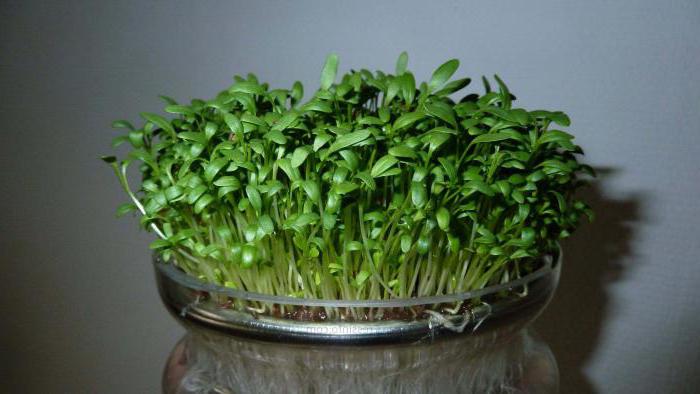

Watercress is widely used in cooking. It is added to fresh vegetable salads, cold soups, served as a side dish for fish and meat.
Instead of conclusions
Watercress is a spicy spicy plant widely used in various spheres of human life. For its pungent taste and specific aroma, it is appreciated in cooking. It is used as a spice or seasoning for various dishes. The valuable composition of the vegetable culture made it indispensable in folk medicine and cosmetology. And its high nutritional value and low calorie content are popular in dietetics. The only thing is not to get too carried away with eating such a plant, otherwise you can get digestive problems or allergic reactions.
More fresh and relevant health information on our Telegram channel. Subscribe: https://t.me/
How to prepare for the winter?
There are three ways to prepare watercress for the winter, which will help preserve the beneficial properties of the plant and allow you to enjoy the vitamin product all winter.
Freezing
To freeze watercress for the winter, it must be thoroughly rinsed under running water, all visible contamination removed and the plant allowed to dry naturally. You can choose to slice the salad or freeze it whole. Any container is suitable for freezing: a plastic bag, a plastic container or a jar. In this way, watercress can be stored for 3-4 months.
Important! The longer the watercress stays frozen, the faster it loses its beneficial and flavorful properties.
Drying
Leaves or stems with roots are used to dry watercress. The plant is washed before drying. If only leaves are used, it is best to spread them out on a clean surface and leave in a well-ventilated area for several days. Whole plants are dried in a hanging position. They are washed, collected in bunches and hung in a ventilated area, with paper under the bottom.
Scattered leaves are also collected and used in winter.
Canning
You can preserve watercress separately or together with other herbs: onions, parsley, dill. To do this, the greens are pre-balanced in boiling water, glass jars are sterilized and the product is rolled up with a small amount of vinegar.
Watercress - growing on cotton wool and in water
A unique feature of the plant, known as bedwort or watercress, is that it can be grown on a windowsill without nutrient soil. The seeds of this green crop contain enough substances to form a full stem and leaves. At the same time, the content of nutrients in them will be at the same high level as when growing in soil. If it is not possible to place pots and boxes at home in which watercress will grow, growing on a windowsill without land can be a pleasant alternative. For greens, watercress - growing on a windowsill without a nutritious substrate allows you to use:
- tissue or paper napkins
- foam or natural sponges
Watercress on cotton wool - pictured
Such a substrate is placed in bowls with a layer of 2 cm (you can also use strong plastic bags), saturate well with water and spread the soaked watercress seeds on the surface. The crops are covered with foil and placed on the windowsill. If we sow watercress on napkins or cotton wool in a bag, it should be slightly inflated and tied. After the emergence of seedlings, the crops are opened. Caring for such beds without soil comes down to timely moistening the substrate, spraying the grown greenery and maintaining the temperature at +10 ﹾ ... + 18 ﹾ С.
An equally interesting and easy way to grow watercress is in a sieve made of fabric or metal, for the implementation of which you will need any container for water and a sieve. Even a mosquito net stretched over a wire frame will do. Water with a temperature of +30 degrees or slightly higher is poured into the lower container.Place the watercress seeds in a sieve and place it in water so that the water touches the bottom of the sieve and moistens the seeds. The grown watercress, grown on the windowsill of which was carried out using a sieve, can be eaten with the roots, because they sink through the cells into the water and remain clean.
Types and varieties
There are two main types of watercress:
- Whole-leaved. It reaches a height of 7-15 cm, covered with large light green leaves. It is often used as a seasoning for first courses or in salads.
- Curly. It got its name from the wide, cut leaves. This species is considered the best for food use.
Another type is distinguished - sowing, or pinnate, watercress. It is considered intermediate between the first two. Differs in poorly dissected leaves and early maturity.
When choosing a watercress for planting, you can come across a variety of its varieties:
- "Fun" - considered an early variety, suitable for growing in the open field, in a greenhouse and on a windowsill;
- "Danish" - the most useful, as it contains the greatest amount of vitamin C and trace elements;
- "Narrow-leaved" - unpretentious to any weather conditions, has a high yield.
- "Kulled" - more suitable for growing at home, has a more pungent taste of the leaves.
Where to start growing watercress
First you need to choose a variety. Good varieties of watercress, suitable for growing on the windowsill: Flagman - 11-13 days after germination, it can be removed;
- Piquant - can be harvested 16-18 days after germination;
- Ducat - harvested after about 19 days;
- Pace - ready for cleaning after 19-20 days;
- Fun - ready for cleaning in 21-22 days;
- Chord - can be removed after 26-27 days.
It is best to purchase a plastic container, it can be in the form of a bowl, bowl, plate, tray, deep pot, for example, for flower plants. The optimal height is 11-12 cm.
Next, you need to prepare the substrate, usually a mixture of soil, humus and river sand in equal proportions.


Watercress
Plant pests
The main pests of the plant are the cruciferous flea and the cabbage butterfly. They can damage the watercress and ruin the entire crop, so it's worth knowing how to deal with pests.
When flea beetles appear, you need to dissolve tobacco dust or wood ash in water in a ratio of 1: 2, respectively, and spray the plant with the solution. Fleas are also afraid of the cold, so you can pour ice water over the watercress.
The fight against butterflies is more complicated, chemical agents cannot be used, so the only way out is to remove weeds and dig up the soil between the rows before planting the seeds. But if the butterfly appeared later, it can only be removed by catching it.
Important! It is not recommended to use chemicals for processing the plant, as they remain on the surface of the leaves and are practically not washed out. Eating such greens can be harmful to your health.
Watercress is a plant that can be used for food all year round. It grows earlier and faster than other types of lettuce, and contains no less nutrients. That is why it is recommended to introduce it into the diet on a regular basis.
The best varieties of watercress
The common name for watercress combines three types of salad. Exist:
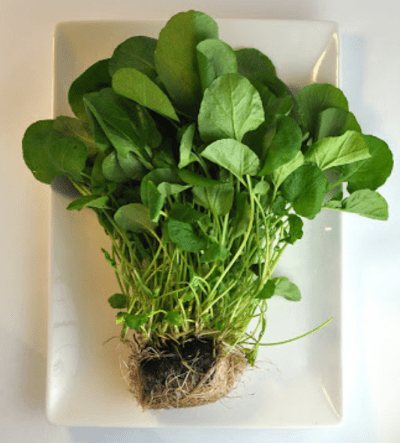

- Whole-leaved
- can be both late and early ripening. With the first shoots, you can taste the first crop. Taking into account the cold resistance of the variety, cultivation is permissible all year round. It takes root well on the windowsill or on the balcony. - Curly
- "cut" of the leaves served as a designation of a variety of medium ripeness. - Sowing
- refers to varieties with fast ripening.
Even experienced gardeners find it difficult to distinguish the seeds of different types of salad. Taking into account the photo on the package, it is not difficult to buy and plant a watercress.But only after the emergence of seedlings, the characteristic forms inherent in a particular variety will be visible.
Among the best representatives of ultra-early ripening varieties, the following are distinguished.
Ducat
Pleasant tart taste of tender and juicy leaves. Ripens before eating in 2-3 weeks.
Dansky
Get spicy, pungent greens quickly in early spring. The variety is distinguished by excellent seedlings.
Spring
The early ripening of the variety, the ability to grow in open areas and at home, instantly made it popular and in demand. Cold tolerant, the spring variety reaches maturity by the third week after germination. Yield frequency - up to 5 cycles per season. At the same time, on the windowsill in the apartment, it is enough to put a container with a 5-8 cm layer of soil. The rosette of large flat leaves with a delicate, juicy-bitter taste reaches 20 cm in diameter. It is convenient to use it as an independent ingredient for fish or meat dishes.
Possible problems
Even with all the rules for growing watercress, sometimes plants can be affected by uninvited guests and diseases.
Pests
The sowing bug is infect only two types of parasites:
- Cruciferous flea... Tiny black bugs are able to make a sieve out of leaves in the shortest possible time, but it is quite simple to deal with them. In hot weather, the plant must be pollinated with tobacco dust. In addition, treat watercress with ice water: this will not harm the plant, but insects that are afraid of low temperatures will disappear.Chemical preparations, the effect of which is aimed at long-term pest control, are dangerous to use due to the short growing season of watercress.
- Aphid... These small insects suck out the bugs' juices, which leads to deformation of green leaves and wilting of the plant. In the fight against them, a soap and soda solution will help. To prepare it, you need to dissolve 50 grams of soap and 75 grams of soda ash in 10 liters of water (can be replaced with 200 grams of baking soda).
Diseases
There are more diseases affecting watercress than pests:
- Gray rot... It manifests itself in brown spots, first on the lower, and then on the upper leaves. A gray or brown fluffy bloom appears on the damaged tissue of stems, leaves and inflorescences. Affected inflorescences die over time. The development of the disease is facilitated by both high air humidity and too tight planting. It cannot be treated safely, so the infected plants are destroyed.
- Leaf spot... It is manifested by the appearance of rounded or angular spots of various colors. In some cases, they are limited to a dark red rim or light brown border. The disease is spread by wind and mechanical means during the growing season. It remains in the soil on affected plant debris. In the fight, the collection and destruction of residues, timely weed control and spraying the testes with Bordeaux liquid or copper chloride at a concentration of 1% help.
- Powdery mildew... Accompanied by a white bloom on the petioles, leaves, inflorescences and stems. Develops, as a rule, in thickened crops. The pathogen can also persist in the soil on plant debris. Regular thinning of the plant, the absence of weeds and the treatment of the planting with a 1% sulfur suspension will help both in the prevention and in the fight against the scourge.
- Downy mildew... With this disease, yellow spots of irregular shape are noticeable on the watercress, limited by veins (especially on the upper side of the leaves). Gradually grow and merge, and diseased plant tissues turn brown and die off. A white or gray powdery coating appears on the underside of the leaf. In young bedbugs, any organ can be affected and killed. Pruning and burning diseased leaves, as well as spraying the testes with 1% Bordeaux liquid will help in the fight.
- Blackleg... The disease affects the root collar of plants, eventually leading to root rot. A constriction develops on the stem, and it bends. High humidity is a major risk factor. Timely thinning of watercress, high-quality loosening of the soil is the best prevention. And with the development of the disease, the affected plants should be treated with Bordeaux liquid or copper oxychloride at a concentration of 1%.
Optimal conditions for diluting the dressing
To grow watercress on a windowsill, you need to create optimal conditions. The plant is not whimsical, but requires a favorable location and lighting, acceptable temperature and humidity, which must be thought out before planting.
Choice of location and lighting
Fast-growing lettuce is a shade-loving plant. He is comfortable even on the windowsill on the north side. It grows well in light rooms, but first you need to plant the grains in the ground. After the first shoots appear, the film is removed and the container is transferred to the windowsill. In the cold season, the culture must be additionally illuminated with special lamps or phytolamps. Daylight hours for a plant should be 14 hours.
Required room temperature
Growing watercress requires an optimal temperature. Seeds germinate well at temperatures above 5 degrees and 10-18 - during growth. To maintain certain conditions, the plant must be frequently sprayed with cold water and the room must be well ventilated.
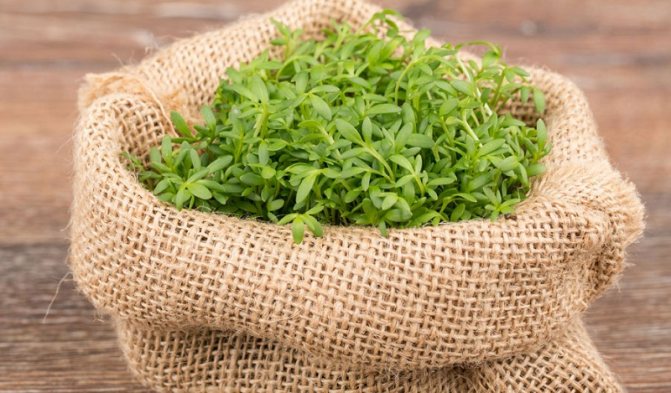

Use in cosmetology
In cosmetology, the plant is used for face and body care. Its rich in nutrients composition has various effects that improve the appearance of skin and hair.
For facial skin
For the skin of the face, the antiseptic and antibacterial properties of watercress are important. Ointments, masks, tonic decoctions and tinctures are made from the seeds and roots of the plant.
For oily skin, a popular mask is made from a tablespoon of crushed watercress leaves with a teaspoon of honey and one egg white. All ingredients are mixed and applied to the face for 20 minutes, after which they are washed off with water. Such a mask fights rashes, eliminates oily sheen, and normalizes the work of the sebaceous glands.
To nourish the skin and improve complexion, make a mask of crushed watercress and sour milk in a 1: 1 ratio. It is applied to the face for 15 minutes, and then washed off with warm water. This mask improves elasticity, evens out skin tone, and prevents the development of wrinkles.
For hair
In hair care, watercress can help fight dandruff. To achieve this effect, the seeds and roots of watercress are ground into powder, mixed with a little water and applied to the scalp over the entire surface of hair growth. If you use the mask 2-3 times a week, the effect will not be long in coming.
Harvesting and storage
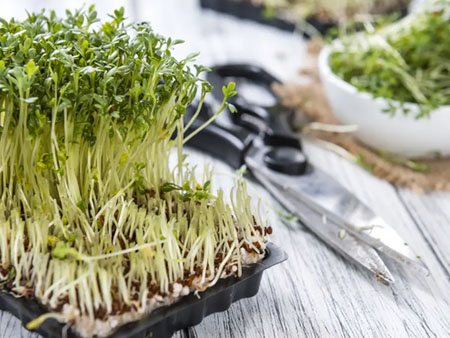

The first crop of fragrant sprouts is harvested 12-15 days after sowing. Late varieties of watercress begin to be eaten after 3 weeks. Young shoots of watercress are of the greatest value. It is recommended to remove the herbs as soon as they grow 8-10 cm. Cut off the herbs with sharp scissors.
Delicate sprouts of miniature lettuce are not subject to long-term storage. A few days after cutting, the greens lose their juiciness, bitter notes begin to prevail in the taste. It is advisable to immediately use the plant for preparing salads and snacks. Watercress is added to hot dishes after heat treatment.
The optimal harvest time is in the morning, when the plant tissues contain the maximum amount of moisture.
What to do if the watercress is overgrown
Shoots with a height of more than 13 cm lose their taste, become coarse, acquire a bitter taste. Sprouts with arrows released also become unusable. In order not to lose the harvest of vitamin spices, you should carefully monitor the plantings.
The problem of overripe sprouts arises when there is an excess planting area. The rapid growth of greenery allows you to plant in small portions every 2 weeks. So you can always have a bunch of fresh spices on hand all year round.
Culture properties
Radicio salad - growing
The green mass of this annual herb contains many useful substances:
- vitamins A, D, E, K, PP, group B;
- ascorbic acid;
- various trace elements;
- essential oils;
- flavonoids and some other active substances.
The benefits of eating such leaves are undeniable:
- stabilizes blood pressure;
- improves the functioning of the heart and blood vessels;
- helps to remove toxins and toxic substances;
- helps to establish the work of the endocrine system;
- watercress is included in the menu of overweight people due to the low calorie content of its foliage;
- the plant should be consumed by pregnant women, since folic acid is present in its composition;
- improves sleep, relieves stress, helps relieve depression;
- prevents the occurrence of cataracts and a number of other eye diseases.
The usefulness of this herb for human health is undoubted, it is also actively used in cosmetology, there are many recipes from the green mass of watercress to improve the condition of hair and skin.
But this plant can also do harm. It should not be eaten by people with the following medical conditions:
- gastritis;
- colitis;
- with peptic ulcer;
- hypotension;
- kidney disease;
- with frequent urination;
- preschool children.
For the first time, you should not "lean" on this herb - you should eat a little and look at the body's reaction, since a person may have an allergic reaction to the components that make up the watercress.


Growing
Harm and contraindications
There are clear contraindications, violation of which watercress can harm the human body.
Watercress is prohibited when:
- urolithiasis (it is able to provoke the movement of stones);
- hypotension;
- gout;
- ulcerative colitis;
- gastritis, gastric ulcer and duodenal ulcer during an exacerbation;
- individual intolerance;
- bronchial asthma and tuberculosis;
- early childhood;
- pregnancy.
When can you cut it?
You can cut watercress from germination to flowering. The most popular type for growing - curly - must be cut off as soon as it reaches a height of 7-10 cm and is covered with green leaves.
Is blooming watercress okay? Definitely not: at this moment it is distinguished by the greatest bitterness and the least amount of useful substances.
Collection and storage
Some varieties of watercress are able to fully ripen in 2-2.5 weeks from the appearance of the first shoots. You can determine the maturity of a plant by the wide leaves of a bright green color, which, when crushed, intensely emit a pleasant spicy, slightly mustard aroma. You can reap the first fruits when the height of the plants reaches about 15 centimeters. The crop is harvested by cutting 10 centimeters of the shoot from above.
The collected plants should be stored exclusively in the refrigerator: they quickly deteriorate and lose their freshness and benefits. In order for the watercress to lie for as long as possible, preserving all the vitamins and nutrients, it is better to place it in a container with cold water, and only after that - in the refrigerator.
To collect seeds for future planting, it is necessary to remove the largest, well-developed rosettes from the soil. As soon as they begin to acquire a brown tint, they should be removed to a dry room, hanging with their roots up. To preserve all the seeds, spread paper, cloth, cling film, etc. under the plant, onto which the seeds will spill out of the plant. Pour fully ripe and dried seeds into a natural cloth bag and store in a cool, dry place until next planting.
Growing watercress is easy. The only 2 conditions that a gardener needs to provide to get a crop are partial shade and periodic watering. And with high-quality soil preparation and other care procedures, you can not only provide yourself with juicy shoots for a long time, but also stock up on seeds for future planting or sale.
0
Care
In the open field
Keeping watercress is easy. The plant beds are regularly weeded and loosened. Loosening is necessary for the flow of air to the roots, and weeding is necessary so that powerful weeds do not strangle the fragile bedbug.
Watercress Salad - what is it
On rainy or just cloudy days, the salad needs to be watered every three days. If the weather is hot, dry, then the plant needs daily watering.
Note! In high humidity conditions, watering watercress can be harmful, as excess water makes it susceptible to fungus. But do not forget that the lack of moisture also affects the plant negatively.
Proper care allows you to get 1.5 kg of lettuce from 1 m2 of land.
On the windowsill
It is recommended to place boxes with bedbugs in shaded, but not dark places. A north-facing window sill or balcony is ideal. The salad should be hidden from direct exposure to sunlight - the bright sun has a bad effect on the foliage. On polar nights, it is also possible to get watercress at home - cultivation is carried out under artificial lighting at a distance of 300-400 millimeters. Bed bugs containers are regularly rotated so that the plants do not stretch upwards.
Water the watercress frequently and abundantly, using a spray bottle to keep the greens soft and aromatic. Low indoor humidity makes plants taste bitter.
Top dressing
In addition to the autumn and spring fertilization before sowing watercress, additional fertilizing can be carried out for its good growth. For these purposes, weakly concentrated solutions of drugs in small doses should be used.
Important! A large amount of fertilizers after planting lettuce in open ground, due to the short ripening period, leads to the accumulation of nitrates in its leaves.
Diseases
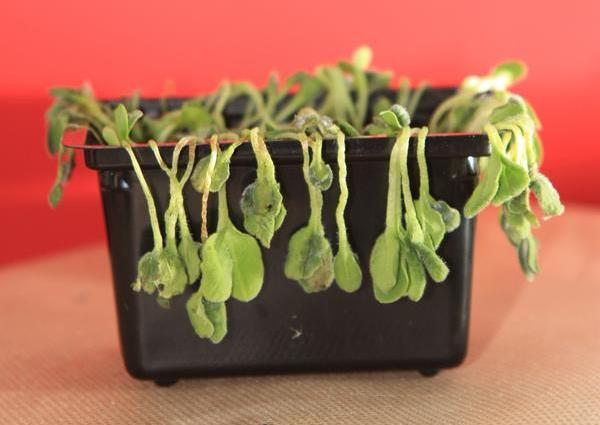

Watercress diseases
Due to the rapid maturation of the bug, it is rarely exposed to diseases and pests, but they are. If the soil is too moistened, a black leg or rot may appear. In this case, the beds are cleaned and the salad is replanted.
The danger is a cruciferous flea, which is fought with tobacco broth. But subject to the rules of crop rotation and maintaining the gap between plants, it does not appear.
Important! It is impossible to process watercress with chemicals - it is dangerous to health.
a brief description of
Iran is considered the birthplace of watercress, but the variety of its properties conquered the inhabitants of the whole world, and today it is grown everywhere. It is added to food, and in African countries a special plant variety is cultivated, from which medicinal oil is obtained, used in cosmetology.
What does it look like?
The watercress looks like a small (up to 30-60 cm in height) plant with a thin white stem. There are many small green leaves at the top. Watercress blooms with the formation of pale purple flowers. The fruits of the plant - the pods - ripen in June-November, but they are usually not used for food: the leaves are more suitable for this. How the watercress blooms can be seen in the photo.
Taste
When they taste watercress, they say that it looks like mustard or horseradish. This is not surprising, because it contains mustard oil in its composition. Its taste is bitter and pungent, but softer than real mustard or horseradish.
Watercress in cooking
Due to its original taste, the plant is used as a savory additive for various dishes.The leaves are used in the preparation of salads, soups, sauces, casseroles, sandwiches, green fresh cocktails.


The benefits of the plant are preserved both in dried and stewed form:
- seasoned with ground dried leaves with omelet or scrambled eggs;
- fruit salads sprinkled with a dried plant acquire an unexpected aftertaste;
- the aroma of grass will subtly emphasize the smell of meat or fish dishes;
- lovers of cottage cheese and cheese can also experiment with the tastes of familiar products.
In order not to be disappointed in the plant, it is advisable to introduce it into the diet gradually. And then it will not be difficult to create your own original recipes for familiar dishes. Since the benefits of dried herbs are less, it is advisable to use them fresh.


How to store?
Watercress spoils very quickly. Once purchased or harvested, the product should be used within two to three days. At the same time, it must be stored in the refrigerator.
Here are some secrets to keep your salad looking fresh:
- it does not need to be washed before being sent to the refrigerator;
- the ideal storage container is a plastic container;
- another option is to wrap the watercress in parchment (this way it will fully retain its taste);
- If you put the plant in a glass of water and cover with a bag, you can extend the shelf life by another couple of days.
Benefit for health
Watercress has many beneficial properties for the body. This is because it contains vitamins A, C, K, B, D, PP and the minerals phosphorus, calcium, iron and magnesium. The main beneficial effects of watercress:
- strengthens the immune system, increasing resistance to various viruses and bacteria;
- has a diuretic effect, eliminates edema;
- normalizes blood pressure;
- strengthens blood vessels, fights cholesterol deposits;
- has anti-inflammatory properties;
- normalizes the thyroid gland;
- used in folk medicine for the prevention and treatment of anemia;
- being an antioxidant, it slows down the aging process;
- slows down the loss of vision, prevents the development of cataracts;
- improves brain activity, eliminates anxiety, fights depression;
- normalizes the digestive tract;
- removes toxins;
- fights overweight.
For women
For women, watercress is an indispensable product. When added to food, it normalizes the functioning of the nervous system, reduces fatigue, improves mood and resistance to stress. Its effect on the thyroid gland, which regulates the female hormonal background, is useful.
In cosmetology, essential oil and watercress infusion are used for face and body care. They eliminate redness, fight rashes and minor cosmetic defects, and prevent the appearance of wrinkles.
For men
Watercress is considered an aphrodisiac, so it helps to increase sex drive and potency. It is also used to treat diseases of the reproductive system, in particular prostatitis. The beneficial properties of the product strengthen the immune system and increase muscle strength, which is very important for men.
For kids
For older children, watercress has the same properties as for adults: boosting immunity, improving brain activity and vision. But small children are prohibited from introducing watercress into their food.
Watercress pests and diseases
Watercress diseases
Since watercress ripens very quickly, diseases do not have time to infect it. In any case, in droves. With regular waterlogging of the soil or substrate, the shoots of watercress can be hit by a black leg, and during the period of prolonged rains, the plant can get sick with rot. In this case, it is best to reseed the watercress, as treating the plant with fungicides can damage your body.
Watercress pests
Of the insects, watercress most often affects the cruciferous flea, the enemy of all cabbage crops.To get rid of it, in hot dry weather, crops are pollinated with tobacco dust or sprayed with tobacco broth. To avoid the appearance of cruciferous flea beetles, observe the crop rotation and plant cruciferous crops at a considerable distance from each other.
Landing rules
Watercress can be successfully grown not only in the beds, but also in a bowl on the window. Planting, growing and caring for it is so easy that any independent child can handle it.
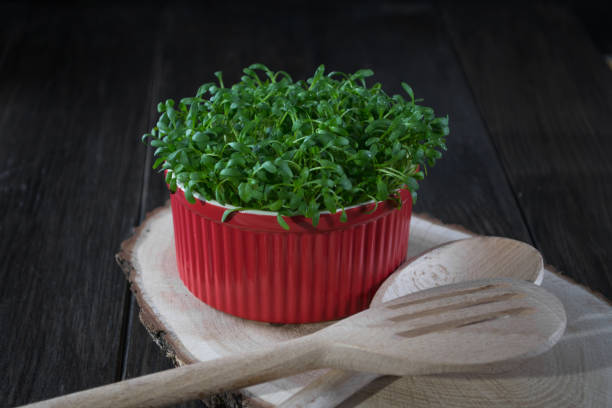

Watercress on the windowsill is not only useful, but also beautiful
Soil selection
Watercress is one of the most unpretentious plants that grows literally in any soil and even without it. “Window-gardeners” grow these mouth-watering greens on ordinary medical cotton wool or food paper napkins. Experiments were carried out on growing plants in different conditions:
- land with water;
- cotton wool;
- just water;
- cotton wool poured with water and sprinkled with earth.
Lettuce grows best in the last planting mix.
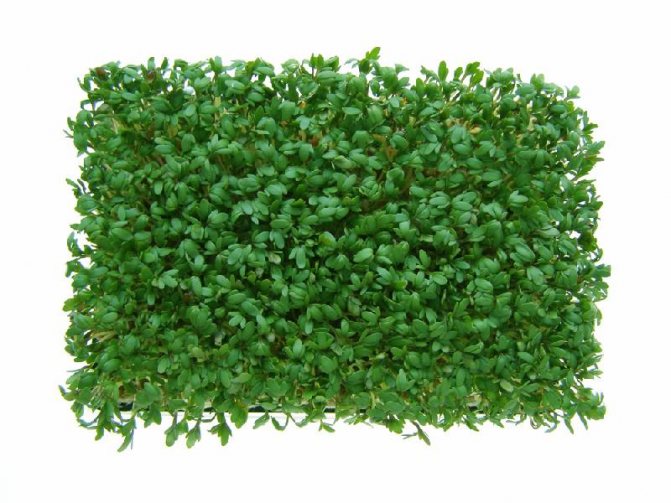

Watercress grows in any soil and even without it
Lettuce grows well in ordinary, moderately moist soil, but the soil must be purchased at gardening stores. If you take the land from the garden, there is a high probability that it may contain eggs of a cruciferous flea - thunderstorms of all plants belonging to the cabbage family. And watercress also belongs to it.
If you plan to sow this plant in the garden, then choose the beds where potatoes, carrots, onions, garlic and other root vegetables grew. You cannot sow watercress after any cabbage crops.
Preparing seeds for planting
Planting any plant begins not only with preparing the soil, but also with the seeds. In watercress, they are quite large, in appearance they are similar to mustard, but oblong.
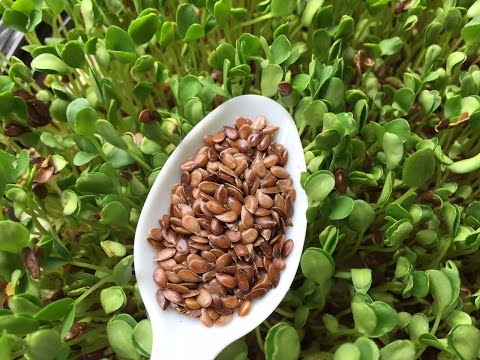

Watercress seeds are large and easy to sow
In order for the seeds of watercress to quickly swell and hatch, they must be placed in any small container, filled with water, which should barely cover the planting material. They are left in this state for 11-15 hours.
When is the best time to sow watercress
In an apartment, the plant can be grown almost all year round. The best time for this is the cold months, since watercress is a cold-loving plant, for which the optimum temperature is + 15 ° С... It is difficult to provide such conditions in summer. And at higher temperatures, the seedlings quickly stretch out, turn pale and lodge.
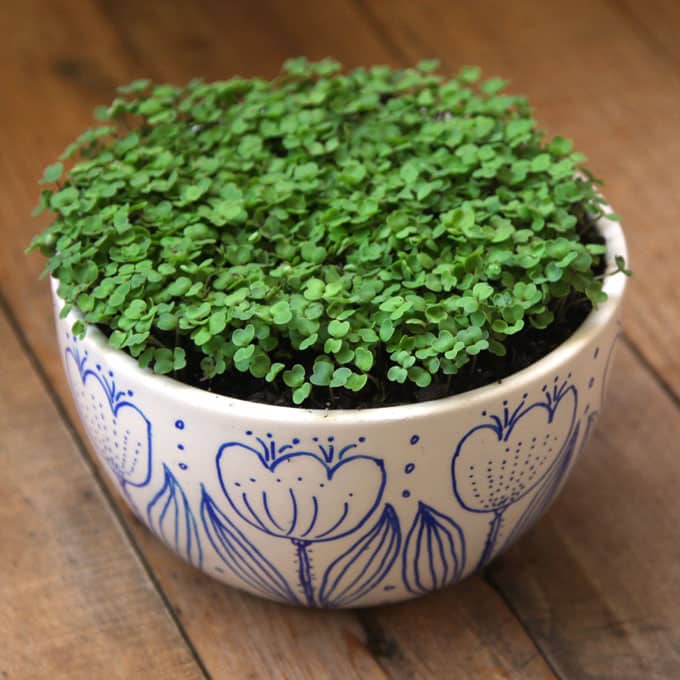

Watercress is a cold-loving plant and feels great at a temperature of + 15 ° С
In open ground, seeds are sown either before winter or in early spring, as soon as the soil has thawed. Even the first, most tender shoots of watercress are not afraid of frosts down to -5 ° C. He, along with parsley, rises first in the garden. It is a fast growing crop that outgrows and shoots out (throws out color). Therefore, in order to provide yourself with constantly fresh watercress, it is planted with regular sowing with a difference of two weeks.
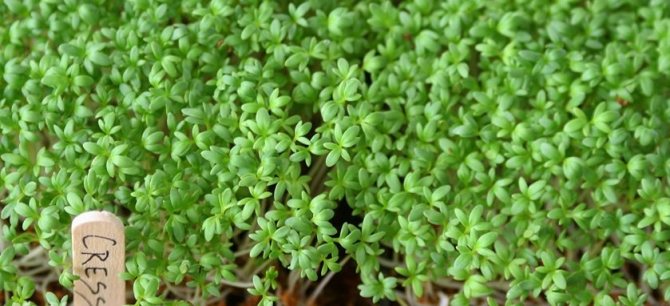

Watercress is one of the first to appear in the garden
Growing technology
Sowing dates
Watercress begins to be sown from the first days of spring - the plant is cold-resistant, tolerates unstable weather without loss. Delicate seedlings can withstand frosts down to -5 ° C. Podzimny sowing is possible.
Watercress is prone to overgrowth, the formation of a peduncle leads to coarsening of the leaves, the amount of nutrients in them decreases. Therefore, it is advisable to sow it several times per season with an interval of 10-15 days.
Starting from the second half of July and until mid-August, over-sowing is not performed: in the hot season, the plant almost immediately throws out a flower arrow, the greens grow sparse, dry, unpleasant in taste.
Site selection and preparation of beds
For beds for watercress, places are chosen with a slight penumbra that lasts all day, at least midday hours: the plant does not like excess sun.On the contrary, in partial shade, the most delicious, tender, juicy leaves are obtained.
Remember!
You cannot plant watercress where representatives of the cruciferous family grew before it - cabbage, radish, turnip, etc.
The soil is prepared in the fall, the beds are dug up, freed from weeds, and humus is added. Depleted soil is ennobled with mineral fertilizers and organic matter per square meter:
- 15 g of potassium chloride;
- 30 g superphosphate;
- 4 kg of humus.
Immediately before sowing, the beds are fluffed and compost is added.
Sowing seeds
Usually, seeds are sown in rows, with a ribbon, or randomly. The depth of the holes or grooves is 1 cm. The soil above the seeds is slightly tamped. It is advisable to cover the March sowing with foil or agrofibre. The first shoots appear in 3-5 days.
Crops are thinned when the third leaf is formed in the seedlings. The step between the plants is maintained at least 3 cm.If you want to get a large leaf rosette, the step is increased to 5 cm.
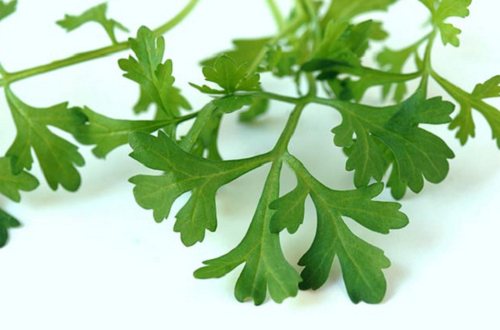

Recommendations
Watercress will be especially useful for people with the following problems:
- high blood pressure;
- disorders in the genitourinary system;
- a lowered level of hemoglobin in the blood;
- scabies;
- lung disease;
- cold;
- joint diseases;
- skin problems;
- disruption of the thyroid gland.
Interesting fact: The ability of watercress to purify blood was known to the great Aesculapius Hippocrates, who for this purpose recommended the use of the plant to his patients.
Pests and control measures
Iceberg lettuce - grown from seed
Since this herbaceous annual has a short ripening period, the pests do not have time to settle on it. In addition, the spicy mustard smell and taste repels most of the "harmful" insects. Improper watering can harm the plant much more. If the soil is too wet, the watercress root system may start to rot or fungus may develop on the plant. Therefore, the main thing when caring for a growing plant is compliance with the watering regime.
Diseases and pests
As a rule, in a short period of ripening, watercress does not have time to attract pests. The danger is posed by soil that has not been treated with potassium permanganate or other antiseptic preparation. The larvae in the soil can hatch a cabbage flea. The small bug is dark green, brownish or mustard in color. It feeds on young leaves and stems.
The pest spreads very quickly and destroys the entire crop. Greens cannot be treated with chemicals, therefore, folk recipes are used. The soil is sprinkled with a thin layer of wood ash, the shoots are sprayed with a weak solution of table vinegar.


Cruciferous flea


Blackleg
The only disease that can affect spicy greens is black leg. The fungus multiplies under conditions of constant waterlogging of the substrate. Especially if the temperature of the content is kept below 10 ° C. You can fight the disease only with preventive measures. The affected sprouts are removed from the bowl at the first symptoms.

